Imagery analysts and geospatial professionals looking for fast, reliable insights are often challenged by cumbersome image acquisition processes and obscure data. Capella’s automated Change Detection solution and high-resolution synthetic aperture radar (SAR) data enables these teams to obtain timely, analysis-ready imagery to more efficiently understand what is happening on the ground. The ability to schedule repeat tasking orders and easily re-task key areas of interest within Capella’s automated ordering and delivery platform allows the customer to be in control, simplifying the process of acquiring compatible imagery for reliable change detection and routine monitoring. Capella’s Change Detection solution highlights areas for investigation, enabling analysts to expedite image interpretation without compromising accuracy.
Recently, Capella was able to use automatic Change Detection to better understand changes that occurred after the Battle of Khartoum in Sudan. On April 15, 2023, fighting broke out between the Sudanese Armed Forces and the paramilitary Rapid Support Forces (RSF). Though fighting and unrest has been widespread through the country of Sudan, the Khartoum airport and adjacent areas have been a focal point of the conflict. The humanitarian impact of this fighting has been significant with no clear resolution in sight. National governments and non-governmental organizations often look to frequently refreshed datasets – such as space-based SAR and electro-optical (EO) sensors – to monitor these potentially unsafe locations from afar. SAR has the unique ability to collect imagery at night and through clouds, which means these organizations always have a clear view of what is happening on the ground.
Finding a Baseline in the Capella Archive
Capella has a continuously growing, global Archive of high-resolution SAR dating back to 2021. To establish a baseline and better understand conditions on the ground before fighting broke out, we leveraged Capella’s searchable Archive to find high-resolution Spotlight and Sliding Spotlight images of the Khartoum airport prior to April 15. The fine ground and radiometric resolution allowed us to establish a baseline understanding of the layout and activity at the airport and its surroundings before the conflict.
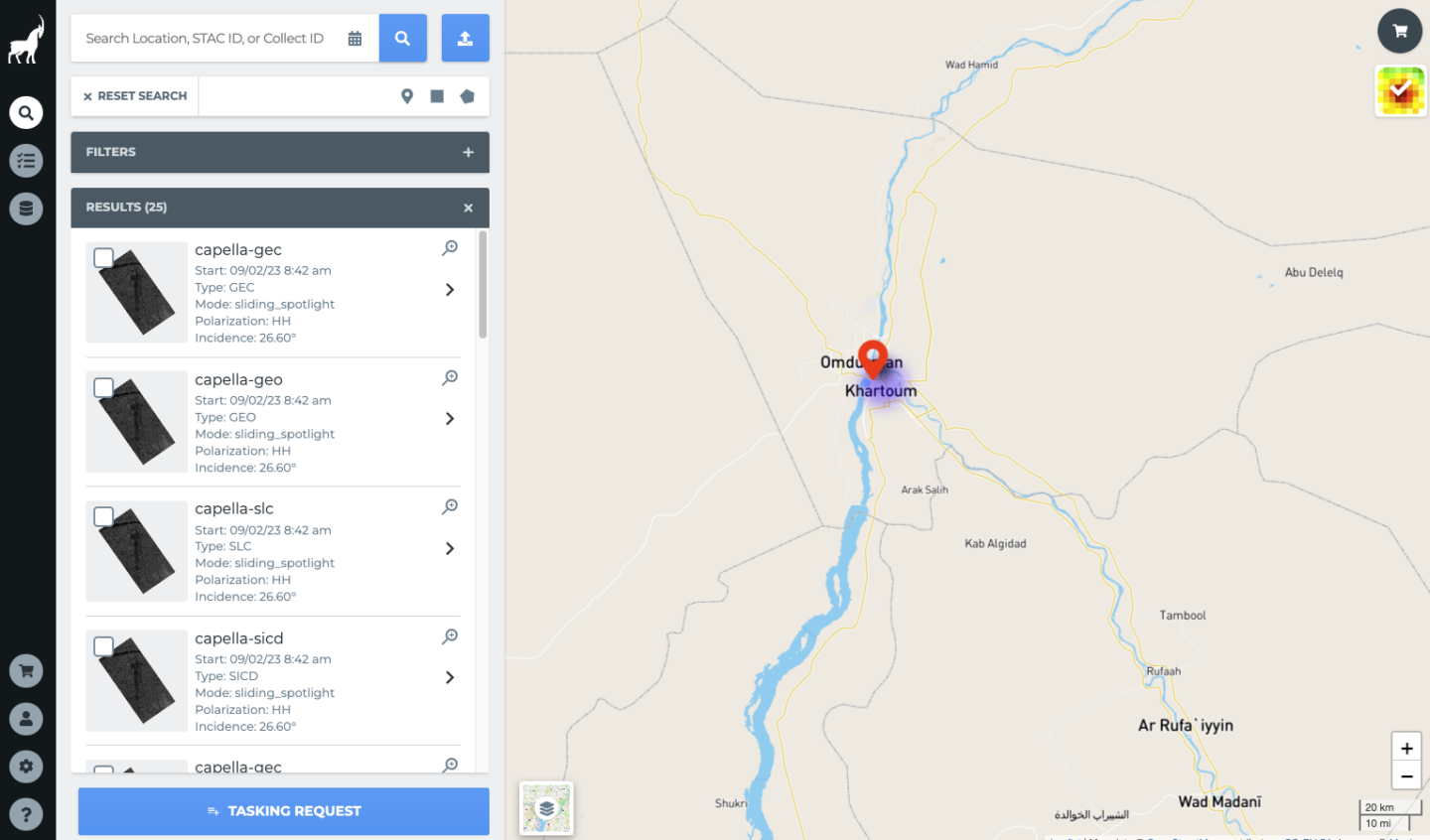
Monitoring the Conflict with Re-tasking and Repeat Tasking
Re-tasking through either the Capella Console or flexible API makes it seamless to acquire a new image that has similar characteristics to an Archive image. The Sliding Spotlight of Khartoum from Capella’s Archive was re-tasked with the same center point, footprint, and acquisition geometry to ensure that post-conflict Change Detection would be accurate and of high quality.
Through Capella’s automated ordering and delivery platform, users have the option to place either a standard one-time tasking order or an automatic repeat tasking order. The coordinates of the Archive image we pulled was re-tasked as a repeat tasking order to acquire a time-series of images with similar geometric characteristics.
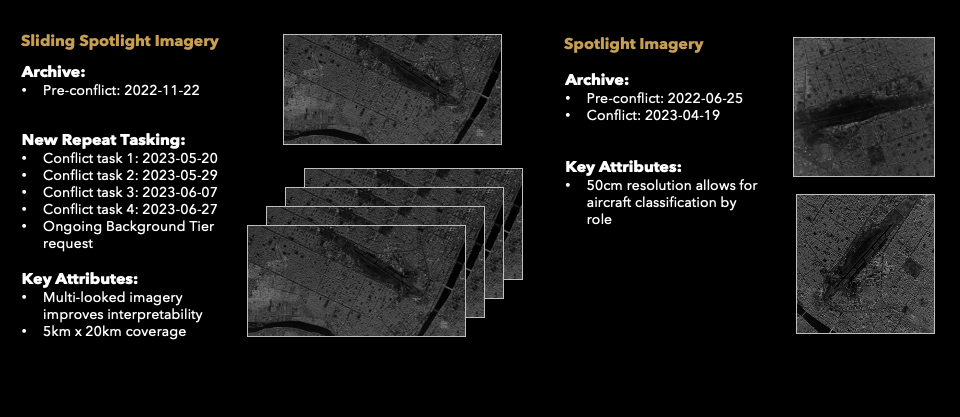
Retrieving the Results and Visualizing Changes
Change Detection compares the amplitudes of two SAR images to help a user identify changes that have occurred between collections. Change Detection was run between the pre/post conflict imagery and automatically against each successive image in the series. The results are color coded according to the ‘red is fled, blue is new’ convention for increased interpretability. Change detection shows the initial destruction and evidence of continued loss through the spring and into the summer.
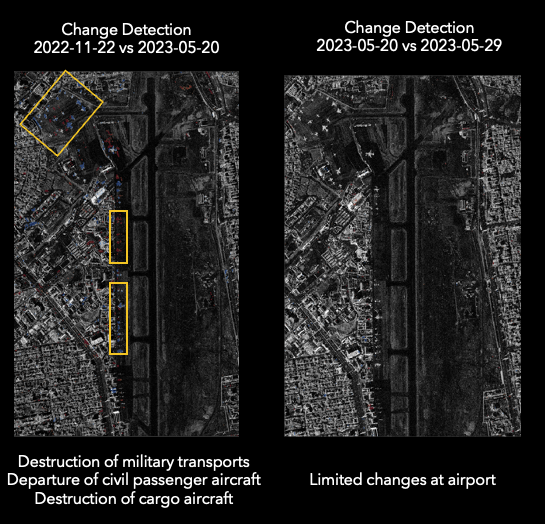
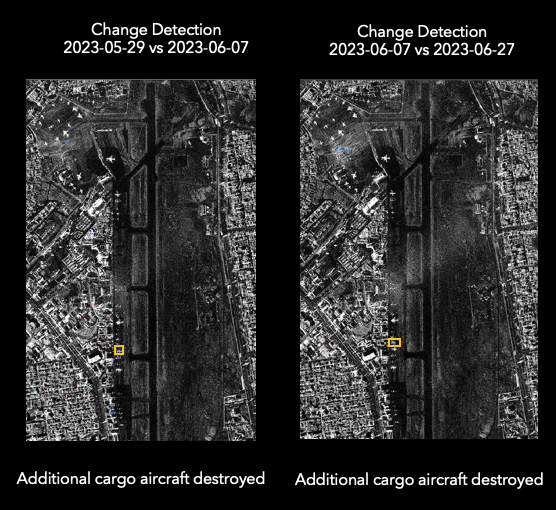
Observing A Precipitous Drop in the Number of Aircraft at Khartoum International Airport
We also leveraged Capella’s Aircraft Detection and Classification beta product to take our analysis a step further and better understand how patterns of life across the airport changed over that time. Capella’s Aircraft Detection and Classification uses AI to detect and classify aircraft by role. This analytic was used to put Change Detection observations into context. Aircraft Detection and Classification was run on the Spotlight Archive imagery pre and post conflict to understand the layout and use of the various parts of the airport and quickly count the total number of aircraft of each type. There is a dramatic drop in the number of aircraft present after the conflict broke out.
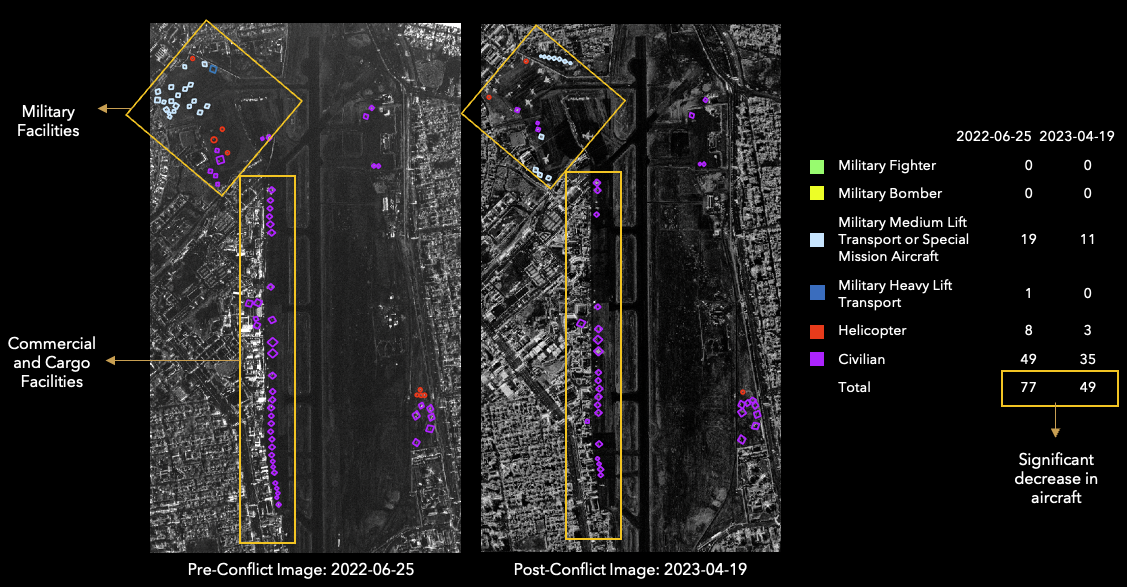
Exploring Changes Detected in the City Reveals an Unsettling Event
The Capella Console was used to set up tasking, view imagery, analytics, and contextual imagery, and download data. Capella’s precise geolocation accuracy allows for the localization of changes detected with point of interest data—addresses and business names—from complementary data sources. In reviewing the imagery and Change Detection, a very distinct change in the city was observed between the images collected on May 20 and May 29. Using QGIS, we overlaid the Change Detection analytic layer over an EO image from Google Maps, and found that this change occurred at the location of the of the United Nations High Commissioner for Refugees (UNHCR) Representation Office, which is located on Ahmed Kheir Street in Khartoum. Through further research, we found that UNHCR reported on June 6 that it had seen a video of a fire at the evacuated office. The Change Detection shows significant damage to the building occurred between May 20 and May 29.
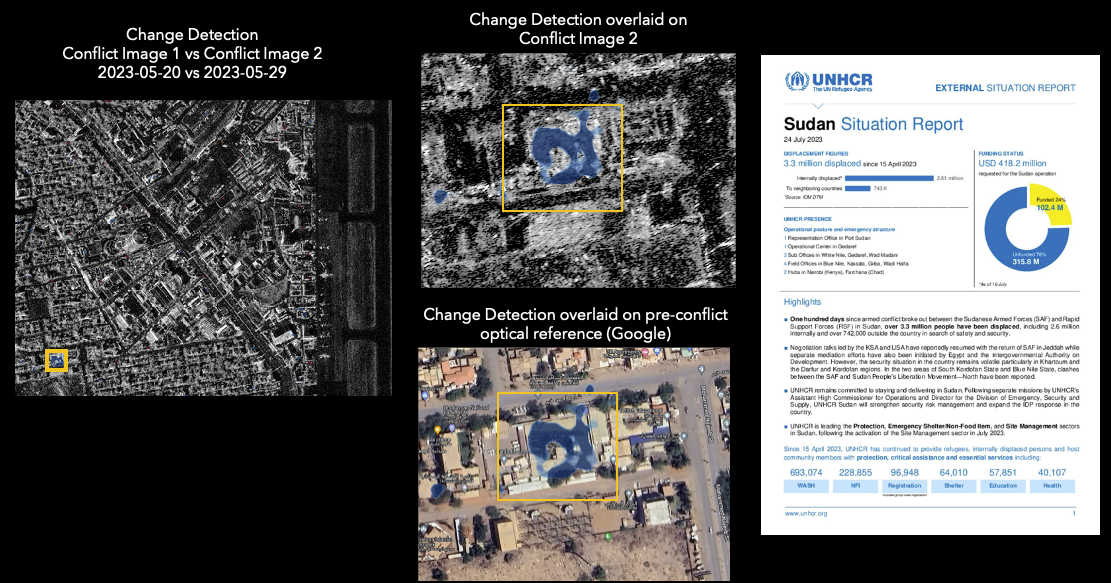
This demonstration shows how Capella’s global Archive, tasking patterns, and automated analytics help governments and non-governmental organizations monitor and understand important world events in near-real time as they unfold. We leveraged the following features—available to any user on Capella’s Console or API:
- Archive Imagery: Capella’s Archive of imagery that has been tasked since 2021 is extensive and growing. Spotlight and Sliding Spotlight images from different dates were available. The fine ground and radiometric resolution allowed us to inspect and improve our understanding of Khartoum before the conflict.
- Re-tasking: Re-tasking makes it seamless to acquire a new image that has similar characteristics to an Archive image. A Sliding Spotlight of Khartoum from Capella’s Archive was re-tasked with the same center point, footprint, and acquisition geometry to ensure that Change Detection would be high quality.
- Repeat Tasking: Repeat tasking makes it seamless to acquire a time-series of images with similar characteristics. The re-tasked image was set up as a repeat task to enable ongoing Change Detection.
- Change Detection: Change Detection compares the amplitudes of two SAR images to help a user identify changes that have occurred between collections. Change Detection enabled the assessment of ongoing damage at the Khartoum airport and led to the discovery of the destruction of the UNHCR office by fire.
- Aircraft Detection: Aircraft Detection and Classification uses AI to detect and classify aircraft by role. This enabled the understanding of the layout of the airport and showed the dramatic drop in the number of aircraft present after the conflict broke out.
- Interoperability: The precise geolocation of Capella’s imagery and its common data formats enable it to be used within GIS and image analysis tools. Comparing Change Detection outputs to Google maps that include address and point of interest data allowed for the identification and validation of the damage at the UNHCR office.

